#Columbia River Treaty
Explore tagged Tumblr posts
Text




















The Webster–Ashburton Treaty, signed August 9, 1842, was a treaty that resolved several border issues between the United States and the British North American colonies (the region that became Canada).
#Webster–Ashburton Treaty#9 August 1842#anniversary#US history#Québec#USA-Canada border#USA#Maine#original photography#travel#Estcourt Station#Parc de la Frontière#International Bridge#New York#Rainbow Bridge#Niagara River#Ontario#Washington#Ogdensburg-Prescott International Bridge#British Columbia#Sault Ste. Marie Canal National Historic Site#Sault Ste. Marie International Bridge#vacation#tourist attraction#landmark#cityscape#architecture#Stewart#Ogdensburg–Prescott International Bridge#Niagara Falls
0 notes
Text
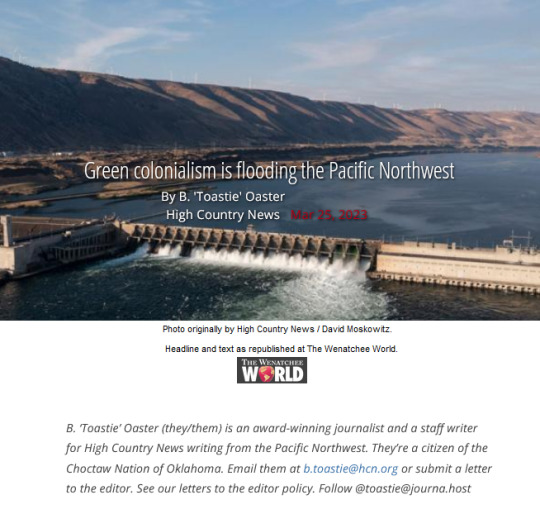
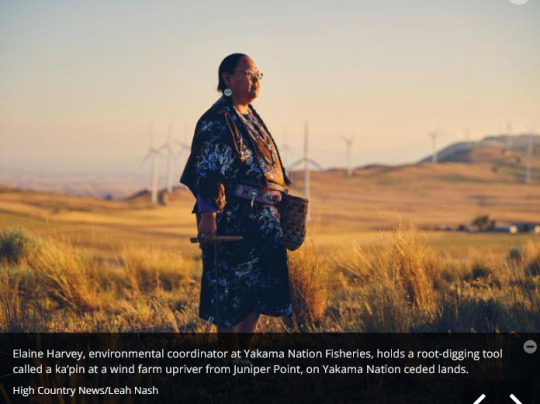
“Is it green energy if it’s impacting cultural traditional sites?”
Yakama Nation Tribal Councilman Jeremy Takala sounded weary. For five years, tribal leaders and staff have been fighting a renewable energy development that could permanently destroy tribal cultural property. “This area, it’s irreplaceable.”
The privately owned land, outside Goldendale, Washington, is called Pushpum, or “mother of roots,” a first foods seed bank. The Yakama people have treaty-protected gathering rights there. One wind turbine-studded ridge, Juniper Point, is the proposed site of a pumped hydro storage facility. But to build it, Boston-based Rye Development would have to carve up Pushpum — and the Yakama Nation lacks a realistic way to stop it.
Back in October 2008, unbeknownst to Takala, Scott Tillman, CEO of Golden Northwest Aluminum Corporation, met with the Northwest Power and Conservation Council, a collection of governor-appointed representatives from Washington, Oregon, Idaho and Montana [...]. Tillman, who owned a shuttered Lockheed Martin aluminum smelter near Goldendale, told the council about the contaminated site’s redevelopment potential, specifically for pumped hydro storage [...]. Shortly thereafter, Klickitat County’s public utility department tried to implement Tillman’s plan [...].
Meanwhile, Tillman cleaned up and sold another smelting site, just across the Columbia River in The Dalles, Oregon, a Superfund site where Lockheed Martin had poisoned the groundwater with cyanide. He sold it to Google’s parent company, Alphabet, which operates water-guzzling data centers in The Dalles and plans to build more. For nine years, the county and Rye plotted the fate of Pushpum — without ever notifying the Yakama Nation.
The tribal government only learned of the development in December 2017, when the Federal Energy Regulatory Commission (FERC) issued a public notice of acceptance for Rye’s preliminary permit application. Tribal officials had just 60 days to catch up on nine years of development planning and issue their initial concerns and objections as public comments. [...]
When the tribe objected, FERC said it could file more public comments to the docket instead of consulting. [...]
When asked what Rye could offer the Yakama people as compensation for the irreversible destruction of their cultural property, Steimle suggested “employment associated with the project.” [...] Presented with the reality that Yakama people might not want Rye’s jobs, Steimle hesitated. “Yeah, I mean I, I can’t argue that — maybe it won’t be meaningful to them.” [...]
Klickitat County’s eagerness creates another barrier to the Yakama Nation. In Washington, a developer can take one of two permitting paths: through the state’s Energy Facility Site Evaluation Council, or through county channels. Both lead to FERC. In this case, working with the county benefits Rye: Klickitat, a majority Republican county, has a contentious relationship with the Yakama Nation [...]. “Klickitat County refuses to work with us,” said Takala. [...]
Fighting Rye's proposal has required the efforts of tribal attorneys, archaeologists and government staffers from a number of departments. [...]
And Rye’s project is just one of dozens proposed within the Yakama Nation’s 10 million-acre treaty territory. Maps from the tribe and the Washington Department of Fish and Wildlife show that of the 51 wind and solar projects currently proposed statewide — not including geothermal or pumped hydro storage projects, which are also renewable energy developments — at least 34 are on or partially on the Yakama Nation’s ceded lands.

---
Headline, images, graphics, captions, and text by: B. Toastie Oaster (High Country News). “Green colonialism is flooding the Pacific Northwest.” As published at The Wenatchee World. 25 March 2023.
1K notes
·
View notes
Text
First Nations groups on the Canadian side of the Columbia River Basin are adamant that salmon runs that have long been blocked by dams in the United States must be restored, potentially in a renewed river treaty between the two countries. But experts say possible solutions, such as “salmon cannons” that suck fish through a pipe and shoot them out upstream and over obstacles, are all costly and potentially limited in their effectiveness. Representatives from the Ktunaxa and Syilx Okanagan nations say they continue to bring up salmon restoration in negotiations for a modern Columbia River Treaty and will not stop until a solution can be reached within or outside a new agreement. The U.S.-Canada treaty regulates the cross-border Columbia River to prevent flooding and generate hydro power. A key component of the 62-year-old treaty is set to expire in September 2024, lending urgency to the ongoing talks.
Continue Reading.
Tagging: @politicsofcanada
116 notes
·
View notes
Text
A Eulogy to the Métis Nation of Canada
Métis Nation of BC (MNBC) has now formally withdrawn from the Métis Nation of Canada(MNC), following in the footsteps of Manitoba Métis Federation(MMF) and Métis Nation Saskatchewan (MNS). Here is a bit of background on what's going on.
MNC was seen as a dead end after MMF and MMS left. The remainder of MNC stopped being viable because Métis Nation of Alberta/MNA held disproportionate power in over the others. So Métis Nation of British Columbia/MNBC elected to pull out and negotiate directly rather than through an organization they would have minimal power to negotiate in. This is my understanding of the reasoning behind MNBC's departure from MNC.
As part of this divide and conquer strategy, MMF is getting a treaty, which is great, but my concern is that this appears to be being done by closing the door on other settlements citizenship pathways. It is currently challenging to register with MMF if you live outside of Manitoba for example. I’m hearing reports this either has somewhat begun to change (it was impossible previously) or is headed towards being changed but at present Métis people are told to register with their province/territory of residence which creates a conflict.
Currently I am aware Métis citizens applying from outside of district have faced friction in getting applications submitted as the process doesn’t even have an option for those currently living outside of Manitoba. This certainly creates the impression that you need to live in the homeland in order to be a citizen, which seems like a very flawed approach to a kinship network based citizenship system where many of us live outside of our traditional territories for work, family etc. This feels a bit like an attempt to force us back to reserve.
There are also reports of severe issues of nepotism and lack of democratic process in MMF which has the rest of us concerned about how they will act when they hold more power than the other nations. .
It was believed that bowing out of MMC was the best of two bad choices, though only time will tell if it was the right choice, being independent for the moment leaves us room to join in a new national movement/representation system if such an opportunity arises. In the meantime, MMF being in charge of rights negotiations for all Métis people sounds like a path towards exclusion for a majority of Métis people and less accountability. This has me concerned.
MNBC has also made many mistakes. Probably more than I am aware of. Locally a previous generation of elected officials made some major tensions with the local First Nations by being very disrespectful, a rift that’s been challenging to heal. Métis Nation of Ontario/MNO was a lost cause and has continued down this path of disrespect which I think is the fundamental reason these cracks began to show so blatantly. MNBC and the other Métis Nations have increasingly distanced themselves from MNO mostly due to this and the shared impression that their citizenship requirements are too lax. Our rights cannot come at the expense of the local land holding nations, which is exactly how the federal and provincial governments like to position the debates.
My concern is that this is being used to close the door to those from Métis settlements outside of the red river valley. My family has both in our past with family from the Red River Valley, Paperchase Reservation and Lac St Anne as well as deeper roots further east in Haudenosaunee and Anashinabeg kinship networks so it’s disturbing to see the other clearly indigenous part of our heritage essentially put out to drift even when it won’t impact my own citizenship significantly.
In general I think settled treaties are being used to close the door on new treaties to try to “wrap up” the reconciliation process from the federal government's viewpoint. This feels like a divide and conquer strategy and disturbs me greatly that so many of us appear to be adding fuel to this fire.
It’s a troubling time to be Métis, I’m very curious to see what developments occur over this next year. This is disappointing in BC for 2SLGBTQQIA+ folx because we just had our bill for representation at the provincial level approved a couple of months ago and now the future of MNBC is uncertain. I’m not sure we will get the same kind of respect and consideration outside of the current framework.
This all being in the backdrop of an anti-incumbent and anti-2SLGBTQQIA+ wave has be extremely concerned for the well-being of my people.
My efforts will continue to be towards building community locally by creating reasons and excuses for us to meet up and hang out as Métis people. At the end of the day, its the community and people that matter and no amount of legislative change will make us stop being proud to be Métis.
Please note that I am speaking as a citizen, not in my capacity as a local chapter’s elected 2S rep. I listened to the debates and gave feedback through our rep (mostly that we needed more time to consult our citizens) but I had no direct vote in this decision.
6 notes
·
View notes
Text
The Biden administration agreed Thursday to spend more than $200 million to fully fund Native tribes’ plans to reintroduce salmon in the upper Columbia River basin — more than 80 years after construction of the Grand Coulee Dam rendered the fish extinct in parts of Washington, Idaho and British Columbia.
The unprecedented show of federal support is a course correction from the previous efforts of some federal agencies to resist tribal salmon restoration, which were documented in an August 2022 investigation by Oregon Public Broadcasting and ProPublica.
“This agreement is the start of fixing a wrong,” Greg Abrahamson, chair of the Spokane Tribe of Indians, said during the announcement of the agreement. “Grand Coulee Dam allowed the desert to bloom, and many faraway cities enjoyed the cheap electricity it produces, at my people’s expense.”
The announcement is also a recognition of the federal government’s long-standing violations of the fishing rights of sovereign tribes, some of whom have signed treaties with the U.S. government. Construction of Grand Coulee Dam destroyed the Columbia River fishing site of Kettle Falls, a regional trading hub and sacred site for many salmon-dependent tribes. It cut off hundreds of miles of river habitat for salmon, who migrate to the ocean as young fish and return to their home waters to spawn as adults. Salmon and other oceangoing fish once accounted for an estimated 60% of the historic diet for Northwest Indigenous people. After the construction of Grand Coulee and other dams in the upper Columbia basin, those fish disappeared.
After nearly 80 years without those fish, a coalition of tribes along the upper Columbia River developed in 2015 a multiphase plan to reintroduce salmon into areas where they’d been blocked.
The tribes’ long-term plan involves building hatcheries, releasing fish into waters above Grand Coulee, tracking their migration and developing plans to pass fish safely around the dams through techniques like trapping them and trucking them up or downstream. They designed the plan to ensure it does not interfere with hydropower generation at the federal government’s biggest dam on the Columbia.
32 notes
·
View notes
Text


Report upon the Fishing Privileges, etc. Guaranteed to Indians in the Northwest with Recommendations with Regard Thereto
Record Group 75: Records of the Bureau of Indian AffairsSeries: Report Upon the Subject of the Fishing Privileges Guaranteed by Treaties to Indians in the Northwest
This is a printed and bound typewritten transcription of an originally handwritten report created by George W. Gordon, Special Indian Agent in the Field. The volume was transcribed and printed by the Department of Interior, Office of Indian Affairs. Included are copies of eight maps, showing usual Native fishing sites on both sides of the Columbia River, and copies of two letters to the Commissioner of Indian Affairs.
Report upon the subject of the fishing privileges etc. guaranteed by treaties to Indians in the Northwest, with recommendations in regard thereto. Geo. W. Gordon Special Indian Agent. In the Field. January 19th 1889. The second document is a map of The Dalles, a town on the Oregon-Washington border. The complete report is available at the link.
13 notes
·
View notes
Text
Events 7.20 (before 1940)
70 – Siege of Jerusalem: Titus, son of emperor Vespasian, storms the Fortress of Antonia north of the Temple Mount. The Roman army is drawn into street fights with the Zealots. 792 – Kardam of Bulgaria defeats Byzantine Emperor Constantine VI at the Battle of Marcellae. 911 – Rollo lays siege to Chartres. 1189 – Richard I of England officially invested as Duke of Normandy. 1225 – Treaty of San Germano is signed at San Germano between Holy Roman Emperor Frederick II and Pope Gregory IX. A Dominican named Guala is responsible for the negotiations. 1398 – The Battle of Kellistown was fought on this day between the forces of the English led by Roger Mortimer, 4th Earl of March against the O'Byrnes and O'Tooles under the command of Art Óg mac Murchadha Caomhánach, the most powerful Chieftain in Leinster. 1402 – Ottoman-Timurid Wars: Battle of Ankara: Timur, ruler of Timurid Empire, defeats forces of the Ottoman Empire sultan Bayezid I. 1592 – During the first Japanese invasion of Korea, Japanese forces led by Toyotomi Hideyoshi captured Pyongyang, although they were ultimately unable to hold it. 1715 – Seventh Ottoman–Venetian War: The Ottoman Empire captures Nauplia, the capital of the Republic of Venice's "Kingdom of the Morea", thereby opening the way to the swift Ottoman reconquest of the Morea. 1738 – Canadian explorer Pierre Gaultier de Varennes et de La Vérendrye reaches the western shore of Lake Michigan. 1799 – Tekle Giyorgis I begins his first of six reigns as Emperor of Ethiopia. 1807 – Nicéphore Niépce is awarded a patent by Napoleon for the Pyréolophore, the world's first internal combustion engine, after it successfully powered a boat upstream on the river Saône in France. 1810 – Citizens of Bogotá, New Granada declare independence from Spain. 1831 – Seneca and Shawnee people agree to relinquish their land in western Ohio for 60,000 acres west of the Mississippi River. 1848 – The first Women's Rights Convention in Seneca Falls, New York, a two-day event, concludes. 1864 – American Civil War: Battle of Peachtree Creek: Near Atlanta, Georgia, Confederate forces led by General John Bell Hood unsuccessfully attack Union troops under General William T. Sherman. 1866 – Austro-Prussian War: Battle of Lissa: The Austrian Navy, led by Admiral Wilhelm von Tegetthoff, defeats the Italian Navy near the island of Vis in the Adriatic Sea. 1871 – British Columbia joins the Canadian Confederation. 1885 – The Football Association legalizes professionalism in association football under pressure from the British Football Association. 1903 – The Ford Motor Company ships its first automobile. 1906 – In Finland, a new electoral law is ratified, guaranteeing the country the first and equal right to vote in the world. Finnish women are the first in Europe to receive the right to vote. 1917 – World War I: The Corfu Declaration, which leads to the creation of the post-war Kingdom of Yugoslavia, is signed by the Yugoslav Committee and Kingdom of Serbia. 1920 – The Greek Army takes control of Silivri after Greece is awarded the city by the Paris Peace Conference; by 1923 Greece effectively lost control to the Turks. 1922 – The League of Nations awards mandates of Togoland to France and Tanganyika to the United Kingdom. 1932 – In the Preußenschlag, German President Hindenburg places Prussia directly under the rule of the national government. 1935 – Switzerland: A Royal Dutch Airlines plane en route from Milan to Frankfurt crashes into a Swiss mountain, killing thirteen. 1936 – The Montreux Convention is signed in Switzerland, authorizing Turkey to fortify the Dardanelles and Bosphorus but guaranteeing free passage to ships of all nations in peacetime. 1938 – The United States Department of Justice files suit in New York City against the motion picture industry charging violations of the Sherman Antitrust Act in regards to the studio system. The case would eventually result in a break-up of the industry in 1948.
2 notes
·
View notes
Text



it hides in the light by Dion Smith-Dokkie
The Bows, April 5th - June 22nd, 2024
it hides in the light presents a new body of experimental mixed-media works by artist Dion Smith-Dokkie that attend to embodiment, interface, information, and infrastructure.
Inkjet-printed stills taken from video works, satellite images of bodies of water, images of daily life, and select found images are broken down into ‘particles’. Using water, the particles are transferred onto paper, creating a collage. In this process, the images are liquefied and lose their discernibility: they synthesize and coalesce. The resulting compositions are further developed with watercolor, gouache, and ink.
The result is an indistinct, luminous work that straddles the line between non-representation and concrete location, videographic and painterly modes. The formal and conceptual tools utilized—mediation and translation via contact, transfer, diffusion, and mutation—become tactics of deliberately sensual and nebulous erotic self-representation. They extrapolate a diffused and empathic praxis of embodiment, self-location, and co-relation.
Dion Smith-Dokkie (he, they) resides uninvited on Musqueam, Squamish, and Tsleil-Waututh homelands and territories. He was born in Fort St. John and grew up in the Peace River region of northeast BC and northwest Alberta. Dion locates themselves as a gay, mixed-race European-Indigenous man who lives with mental illness. He is a member of West Moberly First Nations, a Treaty 8 First Nation. They hold a BA in Women’s Studies from the University of Victoria (2015), a BFA in Painting and Drawing from Concordia University (2019), and an MFA in Visual Arts from the University of British Columbia (2021).
(Photos belong to me and the description and bio are courtesy The Bows’ website)
#i neeeeeeed to go back and see this again#contemporary art#indigenous art#fine art#inkjet#printing#sculpture#curation#my picks#< new tag for the art of others that i post#idk calling myself a curator feels to formal for this but i have curated exhibitions in the past#treaty 7#treaty 8#art#art gallery#artist run centre#visual art#traditional art#queer art#gay#artists#cree#dunne-za
5 notes
·
View notes
Text

First Nations groups on the Canadian side of the Columbia River Basin are adamant that salmon runs that have long been blocked by dams in the United States must be restored, potentially in a renewed river treaty between the two countries.
But experts say possible solutions, such as “salmon cannons” that suck fish through a pipe and shoot them out upstream and over obstacles, are all costly and potentially limited in their effectiveness.
Representatives from the Ktunaxa and Syilx Okanagan nations say they continue to bring up salmon restoration in negotiations for a modern Columbia River Treaty and will not stop until a solution can be reached within or outside a new agreement.
The U.S.-Canada treaty regulates the cross-border Columbia River to prevent flooding and generate hydro power. A key component of the 62-year-old treaty is set to expire in September 2024, lending urgency to the ongoing talks.
“I think what we are doing in the fight to bring salmon back is vital to us moving forward,” said Lower Similkameen Indian Band Chief Keith Crow, who is a member on the Syilx Okanagan Nation’s Chiefs Executive Council and the Nation’s lead in the Columbia River Treaty talks.
“And we’re not going to back down, either,” he said.
The U.S. Bureau of Reclamation says much of the migratory salmon run in the Upper Columbia, both in Canada and the U.S., ended with the completion of the Grand Coulee Dam in Washington state in 1942.
While the Grand Coulee Dam isn’t among four dams built in accordance with the 1961 Columbia River Treaty, First Nations leaders say the talks offer a rare opportunity for them to directly engage American officials about restoring Pacific salmon to the Upper Columbia.
“The salmon hasn’t been a big piece of (the talks), and I’ve been trying to move it forward consistently,” Crow said.
The nation opened its own hatchery near Penticton, B.C., in 2014 to help bring salmon back to Okanagan waters.
The goal, Crow said, is the restoration of natural salmon runs throughout the Upper Columbia Basin.
“We’ve been supplying salmon back to the people for years from our hatchery from the work that we’ve done, but to be able to see them actually swimming freely and coming up the Columbia the way they’re meant to be, I think it’s something I’m hoping I’m going to see in my lifetime.”
Ktunaxa Nation Council Chair Kathryn Teneese said the loss of salmon to the Upper Columbia Basin fundamentally changed communities and their ways of life, since the fish was a staple to traditional diets and held significant cultural value.
“We now have generations of people that have grown up without even knowing that salmon was very much part of our staple diet,” Teneese said. “So, from that perspective, it’s changed who we are. Because one of the things that we say is that we have a word in our language for salmon, but we don’t have access to it.
“We just fill that void with the utilization of all of the other resources off the land that we’ve always used, but there’s just a piece missing.”
Crow said salmon may have comprised up to 50 per cent of traditional Syilx Okanagan diets prior to the region losing its fish runs.
In September, the U.S. pledged more than $200 million over 20 years from the Bonneville Power Administration for reintroducing salmon in the Upper Columbia River Basin.
Crow said he has spoken with British Columbia Premier David Eby about similar long-term financial commitments on the Canadian side.
“Right now, we are kind of doing the best we can with the budgets that we get every year,” Crow said. “So, a long-term commitment would be so much more beneficial. We can get so much more done, I think.”
In June, the province agreed to separate bilateral deals with the Syilx Okanagan, Ktunaxa and Secwepemc Nations so each group receives 5 per cent of the revenue B.C. receives every year from the U.S. through the Columbia River Treaty, funding known as the Canadian Entitlement.
But the challenge in bringing salmon back to the Upper Columbia Basin isn’t limited to funding, experts say.
In 2012, a group of researchers published a report on efforts to restore Atlantic Salmon and other migrating fish species to rivers on the East Coast of North America.
The report found that the effort at three major rivers did not yield “self-sustaining populations in any eastern U.S. river” despite “hundreds of millions” in investment on the construction of hatcheries and fish passages.
“It may be time to admit failure of fish passage and hatchery-based restoration programs and acknowledge that significant diadromous species restoration is not possible without dam removals,” said the report on fish that travel between salt and fresh water.
University of Victoria Biology Professor Francis Juanes was a co-author of the report, and he said that while the topic of fish passage technology among researchers is actively discussed and constantly advancing, studies have shown the only reliable way to fully restore a natural fish run may be a dam’s removal.
Juanes said that when a dam on the Elwha River was removed about a decade ago in Washington state, “you didn’t have to reintroduce (salmon).”
“They came back naturally. In a sense, that is the best way to reintroduce salmon especially to a river system.”
Results on the East Coast where fish ladders were used, particularly the Connecticut River, were not nearly as effective, Juanes said.
“It took so much effort by so many states, and you needed the hatcheries to grow these babies. So, that’s an enormous effort, and the return just wasn’t very good.”
John Waldman, biology professor at Queens College in New York, is one of the main authors of the report.
Waldman said there is rising belief among grassroots and Indigenous groups throughout North America that dam removals may be the optimal way to restore fish runs, in lieu of the poor results from alternative passages.
“I think there’s one universal theme that has emerged over the last two decades, which is that dam removal is without question the best solution to bringing these fish back again,” he said.
“Fish ladders and fish elevators provide what’s called the halfway measure.
“It looks like to the uninitiated that you have a solution and that it works, but the truth is when you look at the actual performance of many of these fish ladders and fish elevators, not that many fish pass through them.”
The biggest dam removal project in the United States began earlier this year on the Klamath River along the Oregon-California border, where four such structures will come down by next year under a budget of US$450 million.
Discussions on removing four dams on another branch of the Columbia River Basin – in the lower parts of the Snake River – have been ongoing for years, with the U.S. federal government rejecting in 2020 the idea due to possible power-grid destabilization if the hydro electricity from the dams are removed.
Last month, U.S. President Joe Biden directed federal agencies to use all available authorities and resources to restore salmon runs in the Columbia River Basin that are “healthy and abundant.”
Biden’s order, however, stopped short of calling for the removal of the dams on the Lower Snake River in Washington state.
The Upper Columbia United Tribes, consisting of five member Indigenous nations in the U.S. Pacific Northwest, said on its website on salmon restoration that while more studies are needed, there have been “encouraging advances” in fish passage technologies such as floating surface collectors and salmon cannons to get past tall dams without the structures’ removal.
But such technology, Waldman said, is unproven in being able to support a large, natural fish migration.
“I think this is a quarter-way measure, not even a halfway measure,” he said.
“You see them emerging once in a while, and somebody gets wind of it on TV, and some late night comedians make fun of fish being shot through these these cannons. But no one’s ever ramped them up to be at a level that would sustain a natural level of migratory fish.”
But Juanes said such options may be necessary if dam removals are not possible, even if they may add stress to the salmon population and make them more vulnerable to diseases.
“For one, that’s a very costly thing to do,” Juanes said of fish-passage technology. “For two, it causes stress to the animals. I can imagine that this cannon is not a happy moment for the fish, but maybe it’s better than it dying below the dam.”
Crow, for his part, said he understands “there’s no way of getting around the fact” that dams such as the Grand Coulee remain in the migration path, posing a monumental challenge to restoring salmon migration routes.
But he said the reintroduction of salmon runs to the Upper Columbia Basin is important enough to warrant effort and funding.
“There are lots of options out there, but what is going to be the most efficient and least impactful to the salmon, and they can still get back up? That’s the key,” he said.
“I’ve been taught to think seven generations down. So, I’m looking seven generations ahead of decisions that I make today: How is it going to influence or how is it going to impact my great-great-grandkids?”
3 notes
·
View notes
Text
"Management of the Columbia River Basin currently prioritizes power production and flood control, largely leaving biodiversity and ecosystems as an after-thought. However, Canada and the U.S are now renegotiating the international treaty that shapes reservoir and river management in the B.C. portion of the Basin. Now is the time to make changes for the future of the Basin" — READ MORE OVER HERE
#kimberleybc#kootenays#kimberley bc#hwy95eh#cranbrook bc#east kootenays#bc#british columbia#Columbia River Basin#Columbia Basin#Columbia River
0 notes
Text
"....in response to the American settlement of Oregon and the news of gold in California, the British government established the proprietary colony of Vancouver Island. Then, in 1858, following a rush of underemployed miners from California to the Fraser River, it established the crown colony of British Columbia. As Daniel Clayton puts it, "native space was reproduced as an absolute space of British sovereignty," (2000, 236) although initially, in the aftermath of the Treaty of Waitangi and judicial rulings in New Zealand, officials in the Colonial Office were uncertain about the extent to which British sovereignty in these colonies was burdened by native title (Harris 2002, 15-16).
With the creation of these two colonies, land was framed in a new problematic. Colonies entailed settlers, and settlers required land, which could be got only by dispossessing native people. A relationship based on trade was replaced by one based on land. As their land was taken away, native people had to be put somewhere. A solution with many precedents in other settler colonies was to put them on reserves. Dispossession began in the 1850s and continued through the rest of the century. Physical violence, the imperial state, colonial culture, and self-interest all underlay it
The establishment of colonies on Vancouver Island and the mainland changed the nature of violence there. It had long accompanied the fur trades. . . in the interior, an axiom of the land-based fur trade was that perceived assaults on the personnel or property of the traders would be met with quick, spectacular displays of violence-sovereign power in the Foucaultian sense, though without a validating regime of rights (Harris 1997, ch. 2). Nor was the gold rush peaceable...
...
But with the creation of settler colonies, a new level of organization and calculation - the British military-was built into the equation of violence (Gough, 1984). British warships operated along the coast; a detachment of Royal Engineers was sent out to survey land and maintain order. Such power was more often displayed than used - a few quick and very public hangings of suspected murderers after summary trials on the quarterdeck of one of Her Majesty's warships, or a few villages shelled and destroyed - spectacles intended to instill fear. Officials considered such power "a grand persuasive." Some held that it saved lives by preventing settler-native wars. Frequently, they judged it sufficient to anchor a warship just off a native village and ostentatiously prepare the guns.
In the interior, the space beyond the reach of a ship's guns, the military equation was more balanced. In the 1870s, as settlers were moving in and preempting land, many natives leaders talked of war. Settlers feared, perhaps with justification, that a native uprising could wipe all of them out in a single night. But, as the chiefs knew, a short-term victory was one thing; keeping at bay settlers and the armies that, sooner or later, would back them up was quite another. The results of wars across the border in which native warriors (some from British Columbia) had fought federal U.S. troops, was evidence in hand. Those who counseled war did so out of desperation. One chief put it this way:
A war with the white man will end in our destruction, but death in war is not so bad as death by starvation."
Overall, the balance of physical power lay overwhelmingly with the state.
...
As liberal humanitarian sentiments about the essential oneness of human kind and the opportunity to create a world of civilized, Christian people faded, responsible government came to dominate protection in Colonial Office thought (Metcalf 1996; Porter 1999). In settler colonies, where access to land was the predominant issue, only a hollow form of responsible government would exclude land policy from colonial jurisdiction. In effect, by the late 1840s and 1850s, the Colonial Office had no clear, consistent native policy. As a result, when the colony of Vancouver Island was created, it was readily inclined to turn over the management of native people to the Hudson's Bay Company (which, it thought, had handled them much better than the Americans) and to rely on the judgment of the fur trader-cum-governor (George Douglas), who managed both colonies until his retirement in 1864. Thereafter, land policies were formulated by local settler politicians. The Colonial Office hardly interfered, and in 1871 when British Columbia became a Canadian province, land policy, now constitutionally a provincial responsibility within the Canadian confederation, remained in the hands of these same politicians. The state created a framework for the ordered development of a settler society, but did not, itself, provide the momentum for the development of that society or for the dispossessions and repossessions of land that accompanied it. When power passed to local politicians, they reflected the values and interests of their constituents.
...
An Indian reserve commissioner, charged with laying out reserves, said this to a native audience on Vancouver Island in 1876:
Many years ago you were in darkness killing each other and making slaves was your trade. The Land was of no value to you. The trees were of no value to you. The Coal was of no value to you. The white man came he improved the land you can follow his example-he cuts the trees and pays you to help him. He takes the coal out of the ground and he pays you to help him-you are improving fast. The Government protects you, you are rich-You live in peace and haveeverything you want.-(cited in Harris 2002, 108)
At the time, few if any white settlers would have disagreed. There were arguments about how quickly native people could be assimilated and, therefore, about how much land should be allocated to them. Some settlers, biological racists to the core, considered natives utterly lazy, degenerate, and unredeemable; but a few found much to appreciate or pity in native lives, were well disposed toward native people nearby, and now and then supported their pleas for more reserve land. But even kindness tinged by an educated, romantic appreciation of nature and, therefore, of lives assumed to live close to nature was situated within the assumptions of the civilization/ savage binary."
- Cole Harris, "How Did Colonialism Dispossess? Comments from an Edge of Empire," Annals of the Association of American Geographers, Vol. 94, No. 1 (Mar., 2004), p. 169-171.
#settler colonialism#settler colonialism in canada#dispossession#violence of settler colonialism#land theft#empire of theory#canadian history#indigenous people#first nations#reading 2024#cole harris#vancouver island#colony of vancouver island#reservation system#royal navy#british empire#canada in the british empire
1 note
·
View note
Text
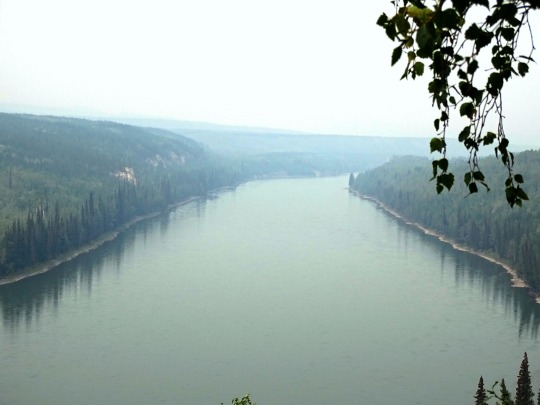
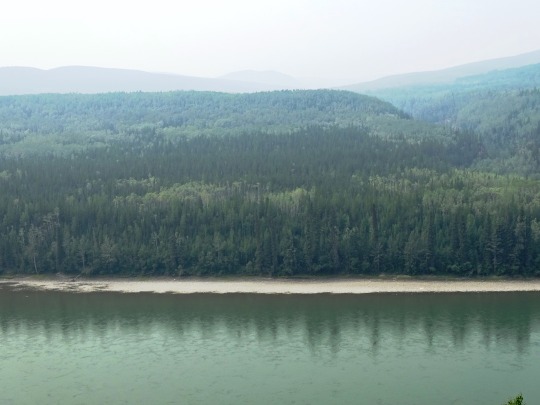
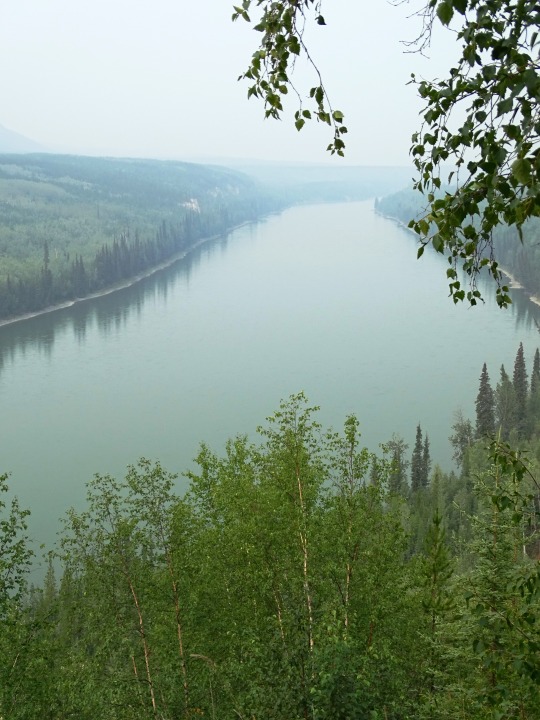
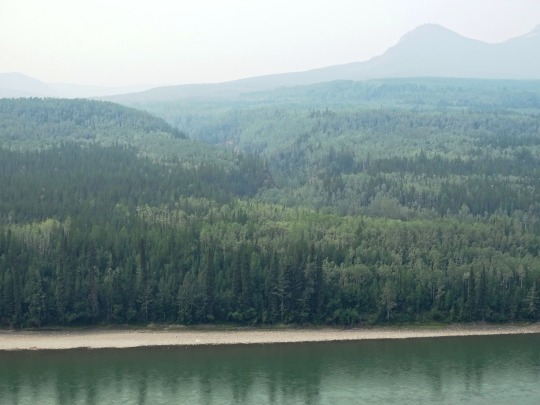
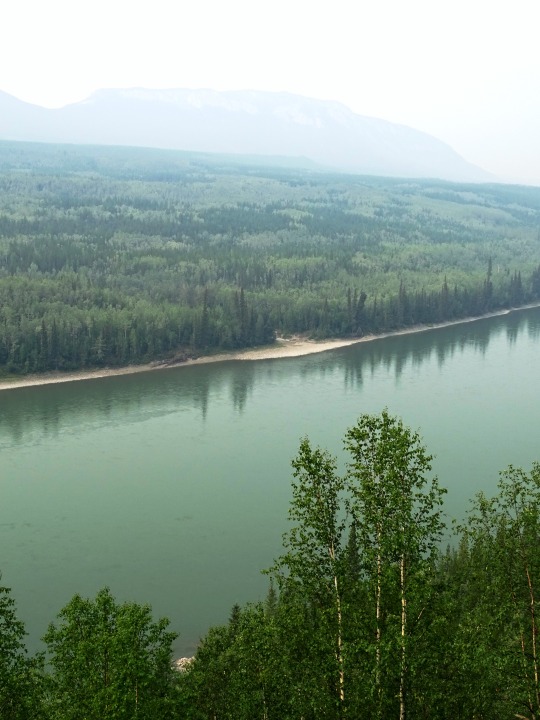
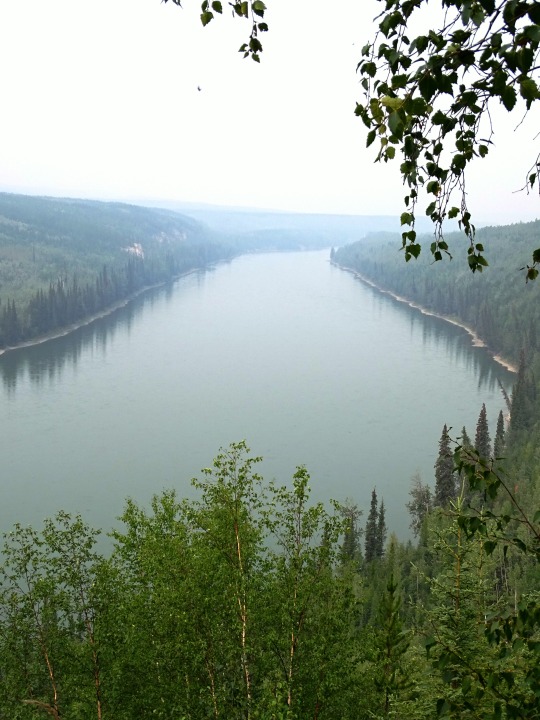



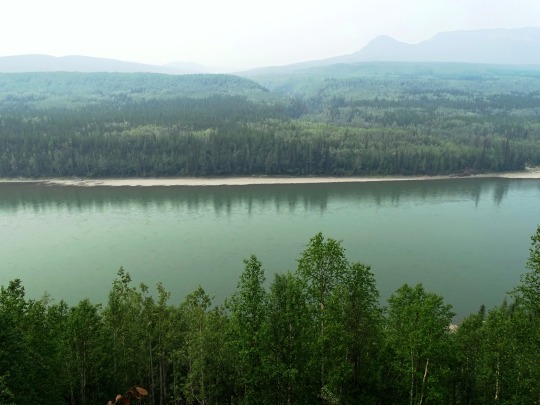
Allen's Lookout, BC (No. 2)
The Indigenous name for the river is Nêtʼił Tué', which means Hanging Down River in the Kaska language. The name comes from a particularly narrow spot near the river's headwaters, where Kaska people used to set goat snares. The "hanging down" - "Nêtʼił" part of the name refers to the snares. The origin of the river's name in mainstream use today is obscure, but is derived from the French word for "Eastern Cottonwood" (a kind of poplar) which grow in abundance along sections of the river. Among the early fur traders, who traveled the river corridor the Liard above the Fort Nelson River was referred to as the "West Branch," while the Fort Nelson River was the "East Branch."
The first European to traverse most of the river was John McLeod of the Hudson's Bay Company (HBC). Leaving Fort Simpson on June 28, 1831, McLeod and eight others ascended the river, reaching and naming the Dease River in just over six weeks. Four days later, they reached the Frances River, and mistakenly ascended it, thinking it was the Liard's main branch. Nine years later, another HBC employee, Robert Campbell, journeyed to the source of the Liard in the St. Cyr Range, renaming the river McLeod had ascended for Frances Ramsay Simpson, the wife of the Sir George Simpson, the HBC's governor who had authorised both expeditions.
The entire Yukon and British Columbia's portion of the river corridor is said to be the traditional unceded territory of the Kaska Dena, who have lived in the area for thousands of years and claim it as their rightful home. This claim is contested by both the Acho Dene Koe First Nation and Fort Nelson First Nation who count among their memberships the former residents of communities along the Liard, east of the Grand Canyon of the Liard, like Nelson Forks, La Jolie Butte, and Francois, where the Acho Dene Koe signed Treaty 11. Their descendants still live and hunt in the area to this day. Despite Kaska Dene claims, much of the area has been recognized as Fort Nelson and Acho Dene Koe First Nation territory under Treaty 8 and 11 since 1910 and 1922 respectively.
Source: Wikipedia
#Allen's Lookout#BC#Liard River#travel#original photography#vacation#tourist attraction#landmark#landscape#countryside#British Columbia#woods#forest#nature#flora#tree#river bank#wildfire smoke#summer 2023#Canada#view#vista point#boreal forest#Northern Rockies#Rocky Mountains#wildflower#blooming
14 notes
·
View notes
Text
Canada, U.S. agree to update Columbia River Treaty that oversees western waterway
The Canadian and U.S. governments have reached a deal on how to modernize the Columbia River Treaty, the decades-old agreement that regulates the waterway that flows from southeastern British Columbia into Washington state. In a statement issued from Washington, D.C., Prime Minister Justin Trudeau said the in-principle agreement will enable officials to update the treaty to ensure continued…
0 notes
Text
Новости Сиэтла - 12-07-2024
Западная Австралия принимает правила захоронения отходов для борьбы с утечками метана.
В Сиэтле были введены новые правила для сокращения выбросов метана со свалок по мере разложения продуктов питания и мусора. По оценкам Департамента экологии штата, эти правила повлияют на 26 свалок, что приведет к сокращению выбросов метана, связанных со свалками, на 38%, что эквивалентно примерно 1,6 миллиона метрических тонн в год. Теперь Вашингтон присоединяется к другим штатам, таким как Калифорния, Орегон и Мэриленд, в принятии более строгих правил захоронения отходов для борьбы с изменением климата.
Новые нормы требуют установки систем сбора газа при более низком уровне отходов и уменьшают время, отведенное операторам для их установки. Теперь операторы свалок должны чаще контролировать утечки и незамедлительно восстанавливать системы. Затраты на внедрение этих правил оцениваются примерно в 10,5 миллиона долларов США на начальном этапе, а ежегодные расходы составляют около 850 000 долларов США. Операторы свалок могут подавать заявки на гранты из фонда в размере 15 миллионов долларов, выделенного из гос��дарственной программы по ценообразованию на выбросы углерода, чтобы помочь с соблюдением норм.
Некоторые свалки, такие как региональная свалка Сидар-Хиллз в округе Кинг и свалка Пайаллап, уже соответствуют требованиям или готовы к их выполнению. Однако существует обеспокоенность тем, что более продвинутые технологии, вроде аэрофотосъемки для обнаружения облаков метана, могут еще более усовершенствовать мониторинг метана и уменьшить выбросы. Основное внимание уделяется предотвращению выброса метана, мощного парникового газа, в атмосферу, поскольку он вносит значительный вклад в последствия изменения климата.

Источник: https://www.seattletimes.com/seattle-news/climate-lab/wa-adopts-landfill-rules-to-combat-methane-leaks/
США и Канада достигли соглашения по Договору о реке Колумбия.
В Сиэтле происходят значительные изменения в соглашениях об управлении энергией и водными ресурсами между Соединенными Штатами и Канадой. США сократят количество энергии, которую они отправляют в Канаду, что повлияет на канадский объем права, оцениваемый в миллионы долларов ежегодно. Это сокращение приведет к дополнительной пропускной способности и экономии энергии в США. Канада теперь приобретет права на передачу, став владельцем, а не арендатором мощностей по передаче элек��роэнергии.
В обмен на получение меньшего объема энергии от США, Канада получит выгоду от расширения интерконнектора к северу от Спокана. Однако точное увеличение электрообмена остается неопределенным. Что касается управления водными ресурсами, США будут платить Канаде за сокращение объемов хранения в канадских водохранилищах, что повлияет на меры по наводнениям. Новая система, предположительно, приведет к неизменным режимам водосброса в большинстве лет, но будет более консервативной в управлении рисками наводнений.
Переговорный процесс продолжается, и заинтересованные стороны с нетерпением ждут конкретных деталей предлагаемого нового договора. Сенатор США Мария Кантуэлл подчеркнула важность регионального мнения перед завершением соглашения. Переговорщики из обеих стран намерены завершить детали договора и представить его на рассмотрение Сената до конца года.

Источник: https://www.seattletimes.com/seattle-news/climate-lab/u-s-canada-reach-deal-on-columbia-river-treaty/
Базирующаяся в Бельвью компания MOD Pizza приобретена калифорнийской группой.
В Сиэтле компания MOD Pizza, известная своими быстрыми и персонализированными пиццами и салатами, активно работает над избежанием банкротства. Компанию, у которой более 500 заведений в 28 штатах и Канаде, приобрела Elite Restaurant Group. Группа стремится помочь MOD Pizza написать следующую главу в своей истории, укрепив свое портфолио, освежив бренд и улучшив опыт гостей. Генеральный директор MOD Pizza, Бет Скотт, выразила волнение по поводу партнерства. Elite Restaurant Group известна своим опытом приобретения и спасения ресторанных брендов от банкротства, включая Gigi's Cupcakes и Project Pie, которые были переименованы в Patxi's Pizza. Это приобретение открывает новую главу для MOD Pizza, основанной в 2008 году Скоттом и Элли Свенсон, поскольку они стремятся к более устойчивому будущему под новым владением.

Источник: https://www.seattletimes.com/business/mod-pizza-acquired-by-california-restaurant-group/
0 notes
Text
For the first time, the government takes accountability for damage done from dams--
"When federal dams altered the natural flow of the river, inundated hundreds of thousands of acres of land, and affected ecosystem functions, the Tribes were disproportionately harmed. The federal and non-federal dams on the Columbia River and lower Snake River transformed the river functions from those the Tribes rely on to those serving other economic ends, transferring wealth away from the Tribes. This transformation followed decades of significant degradation of the rivers and their resources by the Basin’s burgeoning industries. Together with commercial activities and other consequences from settlement of the region by non-Indigenous people, the construction and operation of federal dams impacted salmon, steelhead, and other species in the Columbia River Basin, thus impeding the Tribes’ ability to realize the benefits of their reserved rights, including treaty-reserved rights to harvest salmon at usual and accustomed places, on unoccupied lands, or within reservations. The devastation of once-abundant salmon, steelhead, and other species in the Columbia River Basin adversely and inequitably impacted Tribes’ spiritual, cultural, physical, and economic health as well. Because these impacts continue today and face new threats from climate change, upholding the federal government’s treaty and trust responsibilities to the Tribes includes working to protect these reserved rights and restore associated resources; improving the spiritual, cultural, physical, and economic well-being of Tribes; and advancing environmental justice."
Might just be more false promises.
"...it remains 'hopes and promises' until funding for salmon restoration and renewable power projects comes through Congress. 'With these agreements, there is hope. We feel like this is a moment in time. If it doesn’t happen now, it will be too late.
0 notes
Text
Efforts of tribes pay off in historic agreement on Snake River dam removals
0 notes